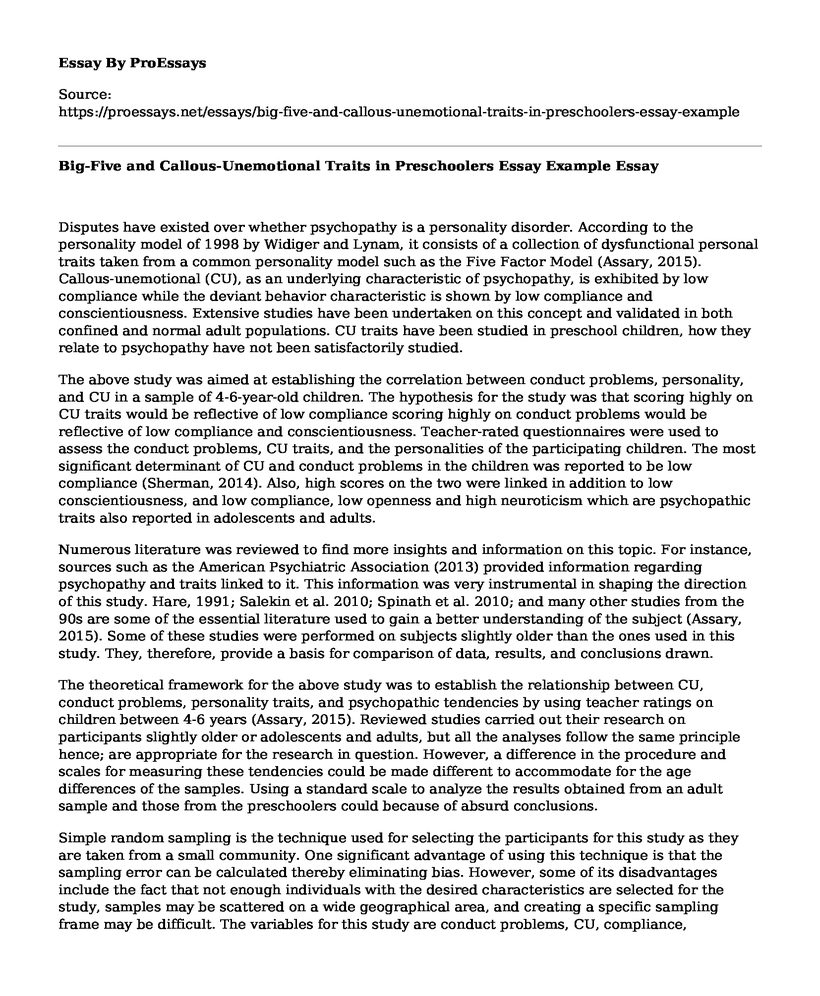Disputes have existed over whether psychopathy is a personality disorder. According to the personality model of 1998 by Widiger and Lynam, it consists of a collection of dysfunctional personal traits taken from a common personality model such as the Five Factor Model (Assary, 2015). Callous-unemotional (CU), as an underlying characteristic of psychopathy, is exhibited by low compliance while the deviant behavior characteristic is shown by low compliance and conscientiousness. Extensive studies have been undertaken on this concept and validated in both confined and normal adult populations. CU traits have been studied in preschool children, how they relate to psychopathy have not been satisfactorily studied.
The above study was aimed at establishing the correlation between conduct problems, personality, and CU in a sample of 4-6-year-old children. The hypothesis for the study was that scoring highly on CU traits would be reflective of low compliance scoring highly on conduct problems would be reflective of low compliance and conscientiousness. Teacher-rated questionnaires were used to assess the conduct problems, CU traits, and the personalities of the participating children. The most significant determinant of CU and conduct problems in the children was reported to be low compliance (Sherman, 2014). Also, high scores on the two were linked in addition to low conscientiousness, and low compliance, low openness and high neuroticism which are psychopathic traits also reported in adolescents and adults.
Numerous literature was reviewed to find more insights and information on this topic. For instance, sources such as the American Psychiatric Association (2013) provided information regarding psychopathy and traits linked to it. This information was very instrumental in shaping the direction of this study. Hare, 1991; Salekin et al. 2010; Spinath et al. 2010; and many other studies from the 90s are some of the essential literature used to gain a better understanding of the subject (Assary, 2015). Some of these studies were performed on subjects slightly older than the ones used in this study. They, therefore, provide a basis for comparison of data, results, and conclusions drawn.
The theoretical framework for the above study was to establish the relationship between CU, conduct problems, personality traits, and psychopathic tendencies by using teacher ratings on children between 4-6 years (Assary, 2015). Reviewed studies carried out their research on participants slightly older or adolescents and adults, but all the analyses follow the same principle hence; are appropriate for the research in question. However, a difference in the procedure and scales for measuring these tendencies could be made different to accommodate for the age differences of the samples. Using a standard scale to analyze the results obtained from an adult sample and those from the preschoolers could because of absurd conclusions.
Simple random sampling is the technique used for selecting the participants for this study as they are taken from a small community. One significant advantage of using this technique is that the sampling error can be calculated thereby eliminating bias. However, some of its disadvantages include the fact that not enough individuals with the desired characteristics are selected for the study, samples may be scattered on a wide geographical area, and creating a specific sampling frame may be difficult. The variables for this study are conduct problems, CU, compliance, neuroticism, and conscientiousness and they are measured qualitatively; high or low scores.
Compliance tests whether or not the participants are generally trusting, conscientiousness whether they are lazy or hardworking, neuroticism is for how they handle stress, CU for how they show emotions, and conduct problem for how they relate with others (Assary, 2015). The researchers had the participants perform different cognitive tasks and fill out questionnaires. The results of the study indicated that higher scores on CU and conduct problems correlated with lower scores on conscientiousness and compliance (Sherman, 2014). The higher scores on CU and conduct problems also indicated higher tendencies for neuroticism. Personality correlates for children with these higher scores is similar to the psychopathic adult.
Conclusion
The conclusion that higher levels of CU in preschoolers were associated with low compliance, high neuroticism, and low openness, and higher levels of conduct problems were associated with low agreeableness, low conscientiousness, low openness, and high neuroticism can be drawn (Assary,2015). Some of the limitations for the study included sample size which limited the detection of small but significant effects. Use of teacher ratings could have been supplemented with parent ratings to provide more validity to the scores across the sources. Also, the use of a brief measure of personality that only allowed for the examination of higher order facets and their relation with CU and conduct problems leaving out lower order facets (Assary,2015). Future research could seek to determine whether psychopathic traits may develop later in life for children predisposed to low compliance at a young age.
References
Assary, E., Salekin, R. T., & Barker, E. D. (2015). Big-five and callous-unemotional traits in preschoolers. Journal of Psychopathology and Behavioral Assessment, 37(3), 371-379.
Sherman, E. D., Lynam, D. R., & Heyde, B. (2014). Agreeableness accounts for the factor structure of the Youth Psychopathic Traits Inventory. Journal of Personality Disorders, 28(2), 262-280.
Cite this page
Big-Five and Callous-Unemotional Traits in Preschoolers Essay Example. (2022, Dec 06). Retrieved from https://proessays.net/essays/big-five-and-callous-unemotional-traits-in-preschoolers-essay-example
If you are the original author of this essay and no longer wish to have it published on the ProEssays website, please click below to request its removal:
- College Should Stop Using Score for Admission - Essay Sample on Education Issue
- Effects of Death on the Development of Children Paper Example
- Essay on Responsibility for Mental Illness
- Counseling Competency Essay Example
- "Second Language Education" Teaching Philosophy Essay
- Essay Sample on Aging: From Birth to Death - What Causes It?
- Paper Sample: Fresh Graduate Aims for Renewable Energy Master's Degree







